Ever wondered how to make a soju bomb? Meet somaek, a popular Korean cocktail that’s taking the Western world by storm. You may be aware of it too, because K-Dramas like “Let’s Eat” and “Double Party” have scenes teaching people how it is done.
Somaek may look easy to make, but it isn’t as simple as you think. You can’t just mix soju and beer together willy-nilly; it’s actually sorta hard to master the soju bomb.
In this article, we dive into the fascinating history of somaek, plus share a recipe to create your very own soju bomb cocktail at home.
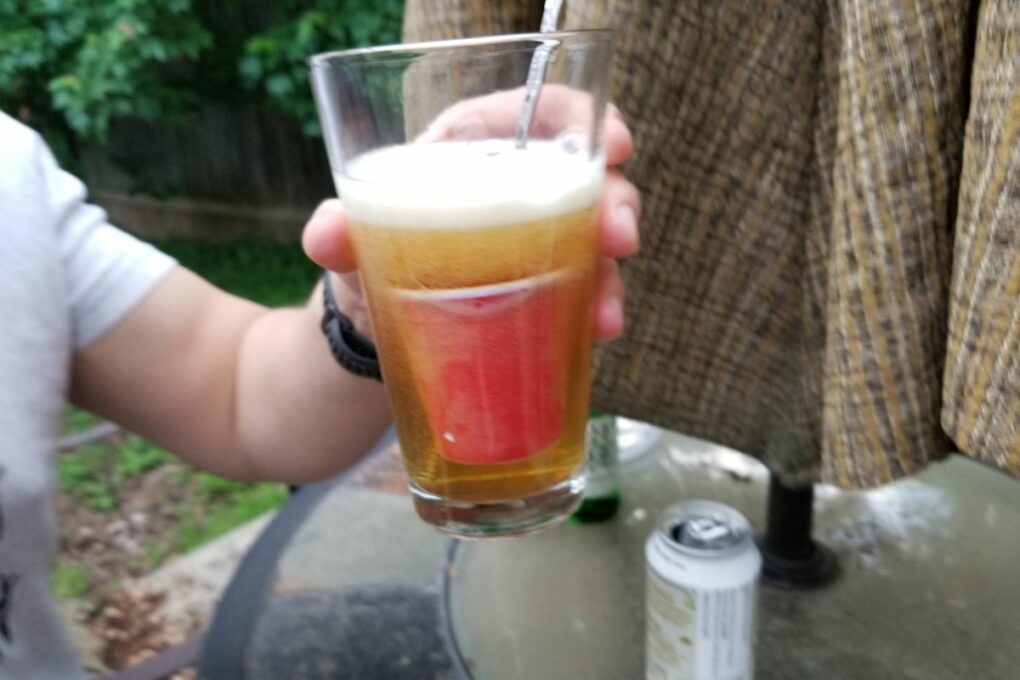
Jump To
Understanding Somaek: Soju and Beer
Somaek (소맥) is a popular Korean cocktail that combines soju (소주) and beer (maekju, 맥주). Known for its slightly sweet-but-not-tart taste, somaek goes well with KBBQ as well as Korean street food. It’s a common belief in Korea that a good glass of somaek helps you unwind after a hard day at work.
What is Soju?
Soju is a traditional Korean spirit usually made from rice, wheat, or barley. It naturally has an alcohol by volume (ABV) ranging from 12.9 to 53%, but according to this survey, most locals prefer weaker soju (ABV below 20%), so the standard bottle of plain soju is around 20% alcohol.
Based on experience, classic soju tastes pretty clean or neutral (sometimes a little bit like vodka), but it can be sweet too, especially if you get the flavored types (not traditionally used for somaek). If you want to try something world class, snag all flavors of Hite Jinro Soju in your local H-Mart.
Is Korean Beer Different?
Maekju is the Korean word for beer, and it’s a widely available drink there; you can get it from convenience stores, restaurants, and even some street kiosks. Once you’ve tried a sip, the first thing you’ll notice is its mild taste compared to a standard Western beer.
Maekju also tastes phenomenal with chicken, so at Korean pubs, they offer group discounts whenever you order chimaek – which is a combination of the words “chicken” and “maekju.” It’s also delicious to have beer with jokbal (steamed pig’s feet) or sundae (Korean blood sausages), though neither of those are as common outside of Korea.
Some popular Korean beer brands include Cass, Kloud, and Terra, which are often used to make Somaek. Note that not all beer will work for a somaek recipe, so forget about craft and specialty beer.
You’ll want to make sure that the one you bought is a lager or pilsner. Moreover, if you want to get the best-tasting somaek, the recommended maekju is Cass Fresh or Hite, also known as Korea’s version of Budweiser.
Origins and Popularity
Nobody can actually pinpoint the origins of this famous cocktail, but it’s said to have been created by really stressed-out office workers who basically wanted to black out drunk after a stressful day. Another story said that this mix came from American soldiers looking for a stronger flavor after being underwhelmed by soju’s clean taste.
I’m not really sure which one is the correct story, but we can all agree that somaek tends to hit the spot. Recently this drink has grown increasingly popular outside of Korea, as well.
In fact, you can spot soju in bars all over the world (specifically in 80 countries… and counting!) Filipinos, for example, became fast fans of the drink after adopting KBBQ culture into their typical company dinners and group outings.
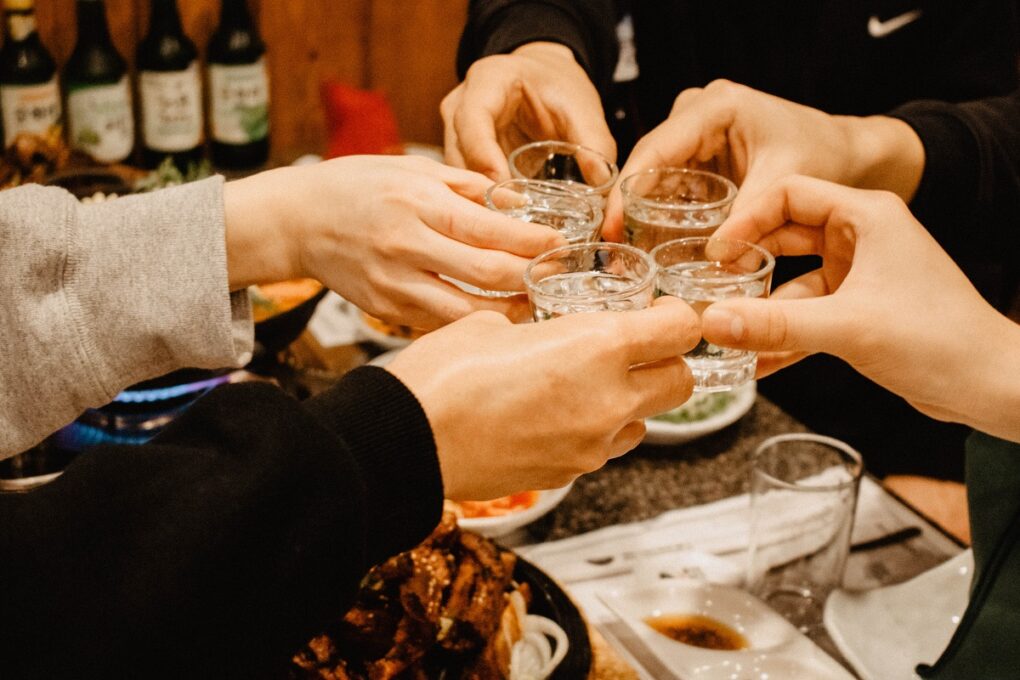
Somaek Origins & History
Cultural Background
In Korean culture, somaek is often used as a way to break the ice, keep the fun going, and to entertain people. This popular cocktail is known far and wide, and most people who come to Korea order one or make one when out to eat.
It’s also the “first drink” most people experience when growing up in Korea, and is typically accompanied by food and conversation. Some of the common anju (drinking snacks) include K-BBQ, fried chicken, and the famous tteokbokki. Plus, it’s a very significant part of the Korean social scene that you shouldn’t miss.
Popularity and Growth
In South Korea, a night out is often incomplete without a glass of somaek. This Korean beer and soju cocktail has become representative of the local nightlife scene. Somaek’s popularity has been boosted by K-Dramas, variety shows, and even in idol culture.
In fact, singing and games are generally a must in the Korean drinking scene. Some games require skill; others require luck. It’s common to play them with friends, or even when you’re with an unfamiliar group and need to do something to speed up the process of getting to know each other better.
Variations and Brands
There’s no official rule for the ratio of soju to beer, but the golden standard for Somaek is often considered to be 3 parts soju to 7 parts beer. This mixture creates a balanced taste that caters to those who prefer either one, once you consider their respective strength.
But if you always want to have perfect-tasting somaek, there is actually a kitchy measuring cup that lets you mix beer and soju according to your favorite ratio. Follow the guide on the side to try all possible combinations from “gentle and smooth” to “blackout.” Always drink responsibly.
You can also manually stack one soju glass on top of another one, and fill it until soju reaches the rim of the bottom glass before adding it to the beer. Brands like Chum Churum (처음처럼), Chamisul (참이슬), and GoodDay (좋은데이) are often the go-to choices for somaek in Korea.
Not only are these popular picks, but mixing any of these soju with beer can result in unique flavor profiles, so you can truly pick a favorite.
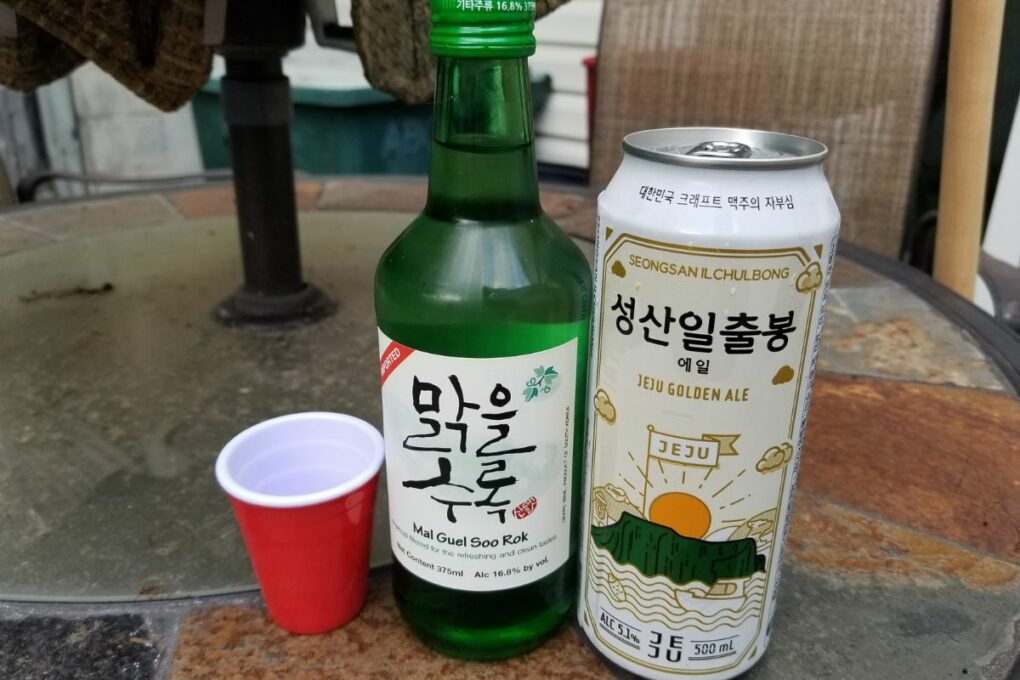
Somaek Etiquette and Serving Tips
Drinking Etiquette
Korea is notorious for its drinking culture. In fact, you may even know that Korea does not have a rule against getting drunk in public (you can still get jailed for public disruption, but never for just being drunk).
It’s also common to see people riding the subway home with the daylights knocked out of them, beyond just being drunk. People don’t usually get this way by themselves, however, even if they’re headed home alone; drinking in Korea is not just about getting wasted.
In fact, Korea has drinking rules that you’re expected to follow. They’re not that extensive, but taking part is an excellent way to immerse in and better understand Korean culture in general. Personally, I learned to be more aware of seating arrangements, hierarchy, and nunchi (the Korean concept of situational awareness).
The gist is, whenever you’re out with your friends, always pour soju for others first before filling your own glass. Make sure to always use two hands whenever you pour drinks for others, and the same goes for those receiving the drink.
Note that if someone is older or of higher social status than you, turn away from them while taking a sip. Also, always toast before taking the first sip - geonbae!
Presentation and Glassware
Somaek is usually associated with a tall glass, but you can actually use a variety of glassware, including the classic pint glass, a highball glass, or even a large wine glass for a more elegant appearance (well, at first).
To make the presentation fun, you need to learn a bit of theatrics, and even opening a bottle of soju can require a bit of skill to pull off. There are different ways to do soju tricks, but Korean baristas like Uno Jang have mastered the art of doing it the classy way.
As for the “bomb” in somaek, some drinkers like to drop a half-full shot glass of soju into beer before sticking a spoon or chopstick in the concoction. Afterwards, they hit the spoon or chopstick to make a loud “ting” sound and the resulting vibration makes the liquid fizz and foam. Then, they chug.
If you want to see a literal “soju bomb,” Place your metal chopsticks on top of your beer glass a bit apart, then balance your shot glass on top. Slam the table with your fist, and watch the chopsticks give way, making the shot glass fall into the beer glass - and boom.
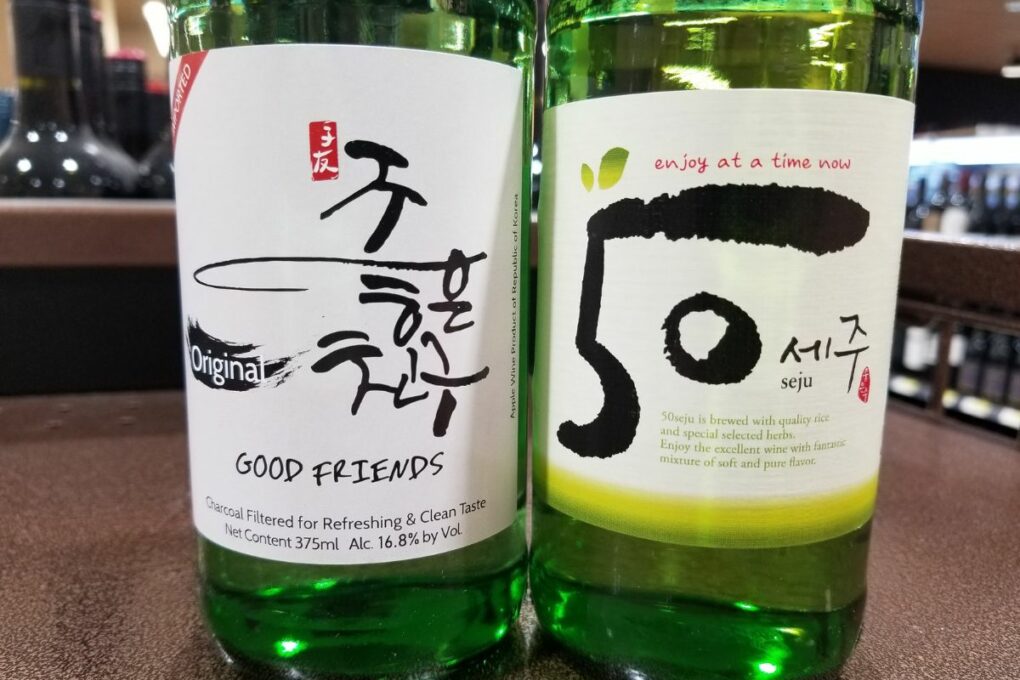
Somaek Recipe
Somaek, also called a “soju bomb” is a widely known Korean cocktail enjoyed around the world. It’s fun and delicious, and it only requires two ingredients: beer (typically lager) and soju.
Ingredients
- Soju – a popular Korean distilled alcohol (examples: Chamisul, Chum Churum)
- Beer – Korean beer or any light lager (examples: Cass, Hite, or even non-Korean beers like Budweiser or Heineken)
- Tall glass or regular glass
- Optional: one chopstick
How to
- Pour soju into a shot glass, filling it about 30%. If you’re not confident about your measuring skills, you can stack this on top of an empty shot glass and use the latter’s rim as a measuring scale.
- Pour beer into a glass, filling it up to about 70%.
- Carefully drop the shot glass into the beer glass and watch it fizz (or don’t).
- If you want it to fizz more, put a metal spoon or chopstick in the middle of the glass and tap it.
- Enjoy the somaek!
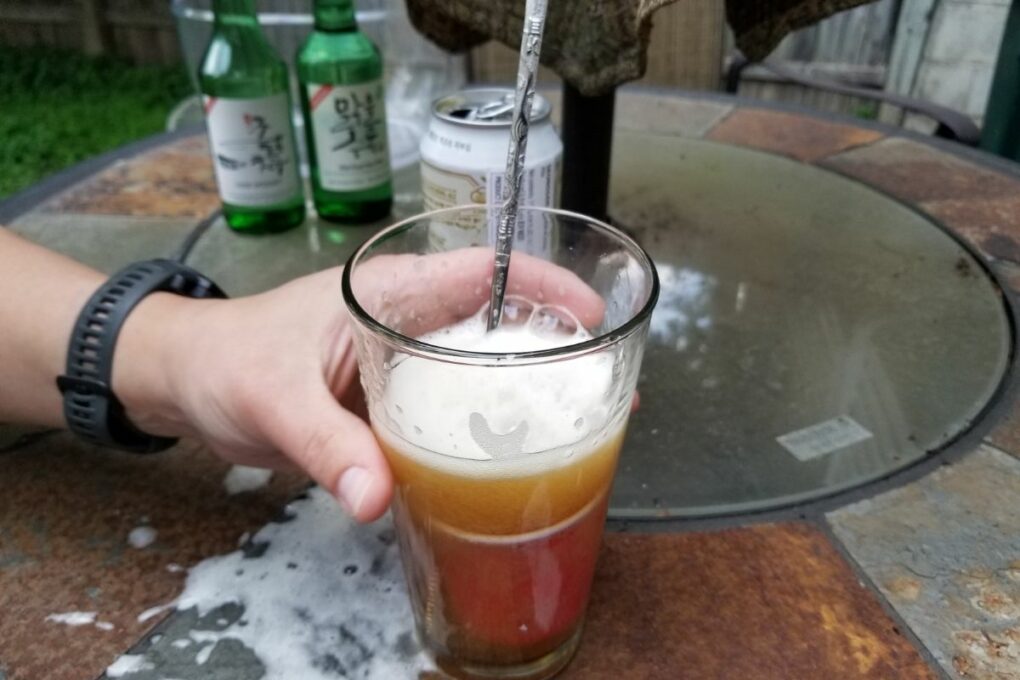
Somaek Variations
For the most popular blend, you might hear the word “Tesla” a lot, but this is not referring to Elon Musk’s company. Instead, this is the mixture of Terra and Chamisul. Nobody understands why it is called that, but Terra’s grainy, somewhat cereal-y taste goes well with Chamisul’s light peach flavor.
There is also the “sweet after bitter” variation (also called “gojingamrae”). You put a shot glass of coke inside an empty beer glass. Stack another shot glass inside and pour soju halfway before filling the whole glass with beer. This makes the sweet taste of Coke come after your somaek, like a chaser for your cocktail.
Those from the younger crowd prefer a different approach when it comes to incorporating coke in their somaek. They just directly pour coke into the somaek to make “somaekcol,” or a variation that college kids claim to be the ideal mixed drink.
Common Substitutions
While the traditional somaek recipe calls for mixing Korean soju with beer, there are several common substitutions that can create slightly different flavors and textures. Some popular substitutions include:
- Light beers: swapping traditional Korean beer for a lighter variety can create a more refreshing drink.
- Gluten-Free beers: If you need a gluten-free option, try using a sorghum-based beer. While it is not exactly the taste of somaek, it still tastes yummy.
- Flavored soju: using flavored soju, such as fruit-flavored options, can add an extra layer of taste while maintaining the drink’s traditional base.
- Non-alcoholic beers: for those looking to enjoy a somaek with a lower alcohol content, non-alcoholic beers can be used in place of a light beer.
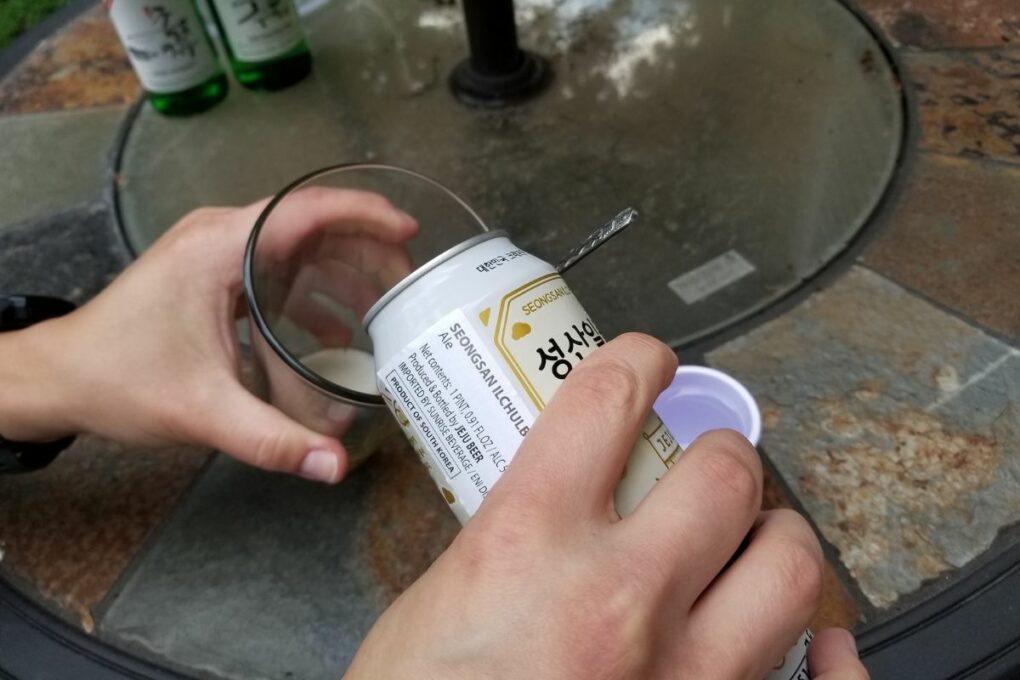
Regional Favorites
Across Korea, there are some regional variations of the drink that are enjoyed by locals. Some of my favorites include:
- Busan: In Busan, a popular variation uses Cass beer and Chamisul soju in a 3-to-1 soju-to-beer ratio. This creates a smoother, less bitter taste.
- Daegu: Daegu locals prefer Max beer with Chum Churum soju, maintaining a similar ratio but offering a different flavor profile.
- Seoul: Seoul residents tend to enjoy a more classic combination, using Hite beer and Jinro soju in equal parts.
The brands of soju and beer used can impact the taste of the cocktail, making each experience unique. Geonbae, however you take it!
Other soju cocktails to try
Soju Bomb Cocktail Recipe Card
As always, if you like the recipe, I really appreciate a 5 star review or comment!
📖 Recipe

Ingredients
- Plain Soju Chamisul, Chum Churum, etc.
- Korean Beer Cass, Hite, etc.
Instructions
- Pour soju into a shot glass, filling it about 30%. If you’re not confident about your measuring skills, you can stack this on top of an empty shot glass and use the latter’s rim as a measuring scale.
- Pour beer into a glass, filling it up to about 70%.
- Carefully drop the shot glass into the beer glass and watch it fizz (or don’t).
- If you want it to fizz more, put a metal spoon or chopstick in the middle of the glass and tap it. Then just enjoy the somaek!
Notes
- Busan: In Busan, a popular variation uses Cass beer and Chamisul soju in a 3-to-1 soju-to-beer ratio. This creates a smoother, less bitter taste.
- Daegu: Daegu locals prefer Max beer with Chum Churum soju, maintaining a similar ratio but offering a different flavor profile.
- Seoul: Seoul residents tend to enjoy a more classic combination, using Hite beer and Jinro soju in equal parts.



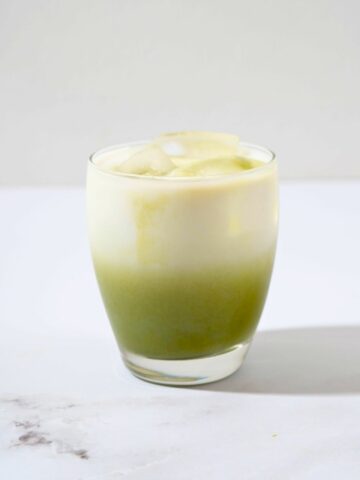
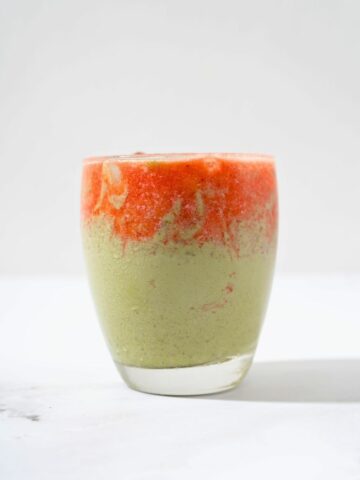
Comments
No Comments